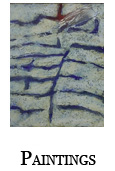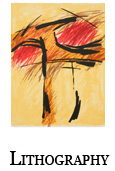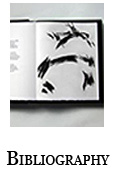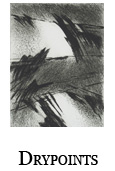
EMANUEL RANNÝ INTERVIEWED
by Martin Hilský
I would like to start with the landscape. I know you are not a landscape artist in the traditional sense of the word, and your works cannot be defined as landscapes. And yet the countryside is a determining factor in your prints. What is the idea behind it? How do you see a landscape? How do you feel it? How do you live it?
I do consider myself a landscape artist. I have lived in the natural environment since I was born, the landscape around me was a matter-of-course everyday thing. When I arrived in Třebíč, the surrounding country, near the villages of Ptáčov and Pocoucov, virtually enchanted me. Unlike the valley of the Svratka River, enclosed by wooded slopes, in which the sun went down early in the day, this is a broad landscape, exposed to the sunshine. I managed to get a sunny site on the outskirts of the city, with views of even the distant countryside, to build a family house there. I not only perceive the landscape visually, but with all my senses. I visit the same places repeatedly, and still find something to admire there. Of course I can admire other landscapes, caressing landscapes that do good to one’s soul. I can feel the countryside in all its breadth and depth, living it to the full. For me, it is not only a source of inspiration, but also of strength and fulfilment.
Perhaps the most famous cycle of your prints is entitled „The Raven Landscapes“. One of your prints bears the title, „Landscape with a Head Facing Back“. But even prints entitled quite differently are related to countryside, and differ from the others merely in the title, not in their substance. „Orbit of the Moon“ is a landscape, and so is „Prayer“. Even „Ashes“ is a landscape. The thing is that these titles are not descriptions, but metaphors. Your prints are in fact metaphors, speaking in a metaphorical idiom. How did your prints combine the Czech-Moravian Highlands with Jan Skácel?
In the early 1980s I still based my prints on drawings made in the open air, within a landscape. Later on, I used landscape, or rather its characteristic elements, to express poetry. I discovered themes in poems that linked them to nature. My landscapes and poetry permeate one another. In prints created to specific poems I always perceive them, but in my subconscious, I can also feel an indefinite landscape. This is how the prints accompanying the various poems by Jan Skácel came about, I think. With the progress of time I gradually withdrew from the Highlands, arriving at the Raven Landscapes.
Another country that enchanted you was Dalmatia. Many of your prints and paintings are pervaded with Dalmatia. The Highlands and Dalmatia are very different landscapes. Do you feel it in that way? Do they in fact create two different poles of your innermost landscape?
Myself and my wife regularly visit Dalmatia, the coast region full of little walls dividing vineyards, a landscape of the sea and light. It is a wonderful landscape that has been created by people for centuries. We stay there outside the tourist season, a month in spring and autumn each. In spring the days are long, there is the yellow-blossoming zhuka, or dyeweed, the innumerable stone walls, loads of rock plants in the Biokov mountains. Bluebells and silvery sage. In autumn the sea is dark steely blue, reflecting both the water depth and the sky. That light, the yellows and the blues found their ways into my paintings. Dalmatia and the Highlands are very different landscapes, but what partially links them is the rhythm of the walls in Dalmatia and of the field and meadow boundaries and slopes of the Highlands. In both places, I made hundreds of drawings, many of them in the same spot. I frequently draw the same motifs, but I always see them differently.
How would you describe the technique of your works to a layperson? What does drypoint mean? What kind of work goes into one print?
Seemingly, drypoint is a simple technique. Unlike etching, lithography and similar techniques in which chemistry is involved, drypoint means engraving directly into the copper plate. It is hard work, indeed. When Professor František Dvořák examined a metre-long engraved copper plate in my studio, he said, “this is what every art historian should see”. Printing in drypoint is also physically demanding, especially large-sized prints. When paint has been applied to the plate, the superfluous material is wiped away by hand, then a wet paper is driven over it between the cylinders of the press. Thus the plate is imprinted on paper and the print as such is finished. I have described it very briefly, but it should be enough.
Before I start work, I walk about the studio, looking at drawings. It takes a long time, even two or three days, before I take courage and engrave the first line into the clean, shining copper. I feel the same tension when approaching an empty white canvas. This work exhausts me, and I need a pause to replenish energy. The longer the pause is, the more difficult the return becomes, though. I do not work every day, I have other pleasures, as well. Poetry, music, drawing and painting save me from the nothingness of the world.
Several of your important prints display titles referring to religious themes: The Kiss of Judas, Prayer, The Crucifixion. One of your paintings is entitled Rosa Coeli. Again, I know that all you want to say on this theme is expressed in your prints. I also know that your idiom of lines cannot be translated into words. Still I would like to ask you, what do religious and spiritual themes mean to you?
There is an enormous power of spiritual energy and some mystery in them. When I had seen Giotto’s frescoes in the Cappella degli Scrovegni in Padua, a number of prints and paintings came into being, The Kiss of Judas among them, from a mere pencil draft on my ticket. This does not apply to Rosa Coeli, though. I found my inspiration in reading a poem by Jan Skácel. I only saw the ruins of the monastery of the same name in Dolní Kounice many years after that. And the Prayer print? I cannot really say where that came from.
Your creative career was linked to the names of various poets. Your prints refer to their poems, and they, in turn, often write about your prints and paintings. What do these encounters of words and images mean to you?
Poets’ views of the world provide a great source of inspiration for me. Friends-poets were capable of expressing my works in words. And for my part, I have always been happy to create an artistic accompaniment to their poems. It was a relationship working beneficially both ways.
A lot has been written about your relation to Jan Skácel. Would you like to add anything?
In the earliest preserved family documents dating from 1750, our surname was spelt variously – Rany, Raný, Ranný, even Rani. So that Jan Skácel’s mother was called Raná. She used to visit us in Štěpánovice, as a small boy I went with her to the wood, whereas uncle Emil took me to Královo Pole railway station. Years later, I visited Jan in the editing room of the Host publishing house, in Besední House and 35a, Kotlářská Street, where he lived. We thought of publishing his poems with my prints. It took a long time, and as late as 1985, a bibliophile edition of twelve poems was published, entitled Landscape with Pendulums. It was accompanied by four drypoints, which I printed myself. Other collections followed in the same arrangement, and Jan always looked forward to seeing them. In 1988 I engraved and printed several half-a-metre prints for various poems, followed by others, later on, until a larger cycle emerged.
What importance did you attach to Ivan Diviš? Or to Ludvík Kundera? What other poets were particularly important for you?
I came to know Ivan Diviš during my frequent trips to Munich. I got interested in him because of his penetrating, sometimes even unsparing view of contemporary world and its history, and because of his clear-cut arguments. Without any scruples, he would speak of what he really felt. In December 1998 Ivan came to my studio to choose drawings for his poems. Ladislav Novák joined us and it developed into an encounter which I still remember with affection. Me and Ivan, we did not see each other so often, but the more we corresponded – we exchanged around fifty letters. I published his Prayer and other poems in a bibliophile edition. After his demise I illustrated a series of his collections of poems for the Academia publishing house.
I met Ludvík Kundera more frequently, in the Q Association, and we visited each other in private, too. I published two of his poems with his favourite blue. Ludvík was a noble person with detached views and a fine sense of humour. There were also others, of course, such as Petr Král, Jiří Staněk, the deceased Petr Kabeš. I still meet many poets at the Seifert Awards, in which competition one of my prints is always part of the prize. I cannot forget Ladislav Novák, with whom I debated at the Winkler restaurant in Třebíč hours on end.
Edgar Allan Poe seems to be the only foreign poet, who distinctly affected your works. Is that so, or is it just an optical illusion?
Edgar Allan Poe is not the only poet whom I became interested in, concerning the overseas. I can name, for example, Lawrance Ferlinghetti, Dylan Thomas, and most of all, Robinson Jeffers. However, Poe was the only foreign poet, as you call it, with whom I actually ‚collaborated‘.
How come you got bewitched by Poe’s The Raven? I do not mean the fact that the raven is, so to say, your emblem bird. What appealed to you in Poe’s poem?
The drama, mystery and the onomatopoeia of the poem. If I remember well, I asked you to translate it, it was in Brno, in the House of Art, at the exhibition of my prints in 1993. However, at the time you were more than busy translating Shakespeare’s works, and you recommended an excellent translation by your former student, Martin Pokorný. In 1997 I published The Raven as a book, with reproductions of the Raven Landscapes, and two years later I did just the English original, as a bibliophile edition, with new drypoint prints. I returned to work on The Raven theme in 2010, when I published it as a bibliophile book with three lithographs. In the meantime, using three copper plates totalling over three square metres, I printed a triptych entitled The Raven Landscape after Edgar Allan Poe. I like the edition of The Raven illustrated by František Tichý, but I did not want to represent it in a traditional way, emphasizing the beak.
You have invested a lot of time, creative energy, and, if I am not mistaken, even financial means in bibliophilia. Your bibliophile editions of Poe’s The Raven are exquisite. The same can be said about the bibliophile editions of Ivan Diviš and the Skácel works. I know how much you care to choose the right kind of paper and print for these publications. Moreover, they are published at your own expense. Why are bibliophile editions so important to you?
Bibliophile editions help maintain the high standard of beautiful books, it elevates the poet’s work and it is a gem for demanding collectors and poetry lovers, to put in their collections. Bibliophile editions are usually carried out by publishing houses, where a lot of people take part in the task. I have always had this desire to publish bibliophile editions on my own. The work is delightful – from choosing the size and kind of paper, to the selection of hand-made script, to the engraving process and print of one’s own works, to the final completion of the book.
So far, we have spoken about you and about poets. Which artists, be them graphic artists, painters or sculptors, were or still are important to you? In this connection, art historians usually cite František Tichý and Josef Šíma. Do you agree? Would you suggest some other artists. What did they contribute to your work or what kind of inspiration did they provide?
They also include Jiří John, whom I knew in person. I still feel great esteem for the profundity and precision of his work. There are several fine artists in this country and abroad whom I admire, but I never dreamt of imitating anyone. I follow my own way. I got this gift to express myself in painting and in prints and I strive to take care of that gift and I am fully devoted to it.
Could you name some events that formed you as a man and artist?
From my early childhood it was an artistic environment – I followed the example of my mother who was a painter with a warm attitude to nature and to literature. Many people came to our house, most of them artists. I felt all this very keenly. In my youth I thus got acquainted with many accomplished persons, mostly older, whom I admired.
Which events, either private or public, most influenced your thinking, your emotions, your life in general?
Moving to Třebíč, a new countryside, my family. In February 1981 my brother Michael died suddenly, less than 35 years of age. Hardly thinking about it, I immediately left my job, it was difficult, but I persevered thanks to my wife, who understood my work and supported me devotedly. In due time my courageous decision proved correct. When in the spring of 1990 my mother died, I worked even harder. In that and the following year I created the highest number of prints, both drypoints and lithographs.
What values do you cherish most?
Family and work.
I know your work speaks for itself, yet I will ask. Could you put your artistic credo in words? How would you express your personal confession as an artist?
I am not afraid to be myself and I never felt the need to join artists‘ manifestos, nor to define and delimit my works for reasons of a lack of invention. What I need is freedom, humility and a perfect command of the craft and material. After I read a book by my friend Ivan Diviš, „A Theory of Reliability“, published in 2002, I imprinted in my mind his words, ‚One has to be indifferent to all rubbish, to scorn all useless things, never to succumb to bribery, and not to let oneself be deceived – that especially!‘
And your life’s credo?
One should try to find little pleasures in every day. Be it a tiny thing or deed, which gives you joy. And in doing it to look forward to another day.
Prague, June–August 2012



